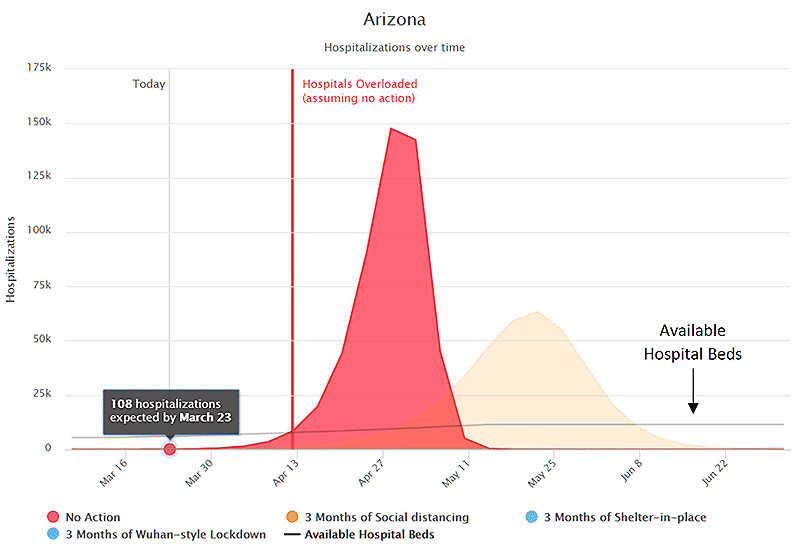Note this forecast page is not the most recent forecast available.
View the most current forecast report
Researchers Develop Forecast Model of COVID-19 Spread For Decision-Makers
This forecasting model for the spread of COVID-19 in Arizona, was developed by covidactnow.org. Researchers at the Mel and Enid Zuckerman College of Public Health at the University of Arizona are working to validate internal models with publicly available forecasts like the model developed by covidactnow.org. The model graph shown here (from covidactnow.org) is based on the most up-to-date data available on March 22, 2020, and was developed to help guide decision making for regional authorities and healthcare providers, it does not predict the future.
Across the state and the country, officials face difficult decisions about the best measures to slow the spread of the COVID-19 virus, measures such as social distancing and the closure of schools and businesses. The University of Arizona has taken major steps to protect the university community including students, faculty, staff and the general public from the spread of COVID-19 (For information about the University of Arizona’s response, visit: https://www.arizona.edu/coronavirus-covid-19-information).
COVID-19 Disease Outbreak Forecast
Arizona State and Pima County
Updated March 22, 2020
Since the March 17 update, 132 new COVID-19 cases have been identified in Arizona, bringing the total number of confirmed cases to 152 (Table 1). Recent growth has occurred faster than previously projected, 1.45X per day versus 1.20X per day. This difference is likely due to expanded access to diagnostic testing rather than faster viral spread. As testing expands, milder cases that would have otherwise remained undetected are diagnosed.

Arizona’s first COVID-19 death occurred on March 20th and its second on March 21st, both in Maricopa County. Given a median incubation period of 5 days (IQR 4, 7) and median time between symptom onset and death of 18.5 days (IQR 15, 22), the initial infections that resulted in these deaths likely occurred during the last week of February. Using various reported case fatality rates and estimated doubling times, there are at least 400 – 800 COVID-19 cases in Arizona today; the number could be as high as 1600 – 2400. More precise estimates are not possible until more testing or more deaths occur. Now that more sophisticated models are available, those new models are being applied (Figure 1).

Figure 1. Arizona Projected COVID-19 Hospitalizations and Hospital Capacity (https://covidactnow.org/state/AZ)
Note: The blue graph colors corresponding to 3 Months Shelter-In-Place and to 3 Month Wuhan-style Lockdown do not appear on this graph because under those preventive measures, the disease would not peak in the time-frame of this graph.
Point of no-return for intervention to prevent hospital overload:
March 29 to April 3
COVID ACT NOW projects there have been 103 COVID-19 hospitalizations in Arizona which represents only 2% of the available beds needed to care for them. However, without more restrictive social distancing interventions, the number of COVID-19 hospitalizations could exceed available bed capacity as early as April 12th. However, instituting Shelter-in-Place restrictions before April 3rd could avoid such a scenario. It’s not too late to act!
Pima County
Since the previous update, 13 new COVID-19 cases have been identified in Pima County bringing the total number of confirmed cases to 17 (Table 2). Recent growth has occurred faster than previously projected, 1.29X per day versus 1.20X (Figure 2). Again, this is likely attributable to expanded testing capacity. No deaths have yet been reported in Pima County.

Recommendations
- To ensure we do not exceed our capacity to care for critically ill COVID-19 patients, more restrictive social distancing interventions must be instituted before April 3rd including at least “shelter-in-place” advisories:
- “Voluntary/VolunTold “shelter-in-place” community-wide home quarantine (especially firm for high-risk groups), shutdown of non-essential businesses, close schools, ban on events over 10 people, passive monitoring, public advocacy around social distancing and enhanced hygiene. Possibly closed borders or restricted travel. Public aid relief bill. Roll-out of free population-wide testing and quarantine, so that quarantines can be relaxed for those who are not infected.”
- To facilitate forecasting/monitoring the impact of such measures, the Arizona Department of Health Services should report the daily number of hospitalized patients including those in critical care settings (e.g., ICU) and those receiving mechanical ventilation. These reports should be archived by date rather than as updated daily totals.
- Case counts, by themselves, are no longer adequate measures of viral burden and/or spread owing to limited testing capacity, changing testing requirements, and uncertainty surrounding the number of undiagnosed cases, the proportion needing hospital-level care, etc.
- The Governor should appoint a state-level Testing “Czar” and supporting advisory panel consisting of industry representatives, public health professionals, and epidemiologists to coordinate public and private COVID-19 testing. The Governor should also consider taking control over specific aspects of public, private, and research laboratories to substantially expand COVID-19 testing and standardized testing practices. Current testing capacity is inadequate and uncoordinated. Because of the consequences and probability of nosocomial transmission, testing priority should be given to the following groups:
- Hospitalized patients with COVID-19 symptoms, then
- Health care professionals (e.g., hospital personnel and first responders), then
- Patients with COVID-19 symptoms who present to outpatient facilities, then
- Public health surveillance efforts including repeated testing of randomly sampled populations to determine population prevalence as the outbreak progresses, then others as warranted.
- Economic relief to individuals and small businesses most affected by social distancing measures including enhanced unemployment benefits, Medicaid eligibility, food assistance, postponement of business and home foreclosures, and more restrictive eviction criteria is urgently needed.
Download March 22, COVID-19 Pima County Forecast as a PDF.
Based on what we know now about this pandemic, we support guidelines for social distancing to slow the spread of the virus and urge everyone to follow the recommendations provided by the Centers for Disease Control and Prevention (CDC) to protect yourself, your family, your neighbors, and your employees. Please heed the recommendations as provided by the CDC, found at the following website: https://www.cdc.gov/coronavirus/2019-ncov/prepare/prevention.html
COVID covid coronavirus virus covid19 corona








